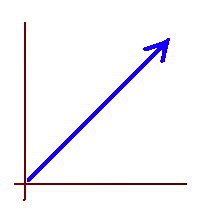Building up concepts a little bit at a time.
Beyond a certain age, most students can handle negative numbers. Some make mistakes sometimes, like forgetting writing the negative sign in front of the result, or subtracting the numbers when they should add them but in general they have the concept of negative numbers and their operations.
This is different for little children who have not yet been exposed to the subject.
Today I asked one of them:
“How much is 3 minus 5?”
He said:
“That’s impossible!”
I said:
“O.K., well, let’s see.. Have you ever borrowed money?”
I led him through the example of owing five dollars, having three in our possession, paying that amount and ending up owing only two.
Then I pointed out the fact that five minus three equals positive two, while three minus five equals negative two, and I continued:
“So, it is possible to subtract a big number from a small one, and the way we do it is we really just subtract the small number from the big number, and we write the result with a negative sign in front of it.”
Then he summarized his understanding as follows:
“Yes, a big number minus a small number we know how to do that, and a small number minus a big number is possible only if it’s money, or something like it.”
I thought that was really funny but the key point here is in his mind he moved the concept of “small minus big” from “impossible” to “possible only if it’s money.” So now he accepts the possibility of such an operation at least in some cases.
This illustrates another point, that learning most often than not is a gradual process, where we build up concepts a little bit at a time. Students require several exposures to negative numbers and to the rules governing operations with them, before they can feel comfortable handling such operations. These exposures better be gradual, clear, consistent, and such that the student gets a feeling of success about them. Otherwise confusion sets in, and with it the seed of long-term frustration.
I remember the following dialog with another student a few months back, when I asked her:
“So, when we multiply two negative numbers, what is the sign of the result?”
She said:
“Negative numbers are baaad!”
I asked:
“Really? How bad?”
She answered:
“Negative numbers are evil!!!”
I found that comment very funny, I smiled and I said:
“O.K., well, somehow we have to deal with the fact that your teacher for some obscure reason wants you to add and subtract and multiply those evil numbers so, how are we going to do that?”
Then she said:
“Well, maybe they are not always that bad after all.”
Usually it is not easy to discover (let alone clear them) the blockages installed in a student’s mind around a concept by virtue of unsuccessful teaching techniques.
The problem here is that every teaching technique is very effective with some students, while at the same time being totally useless with some others. Given the amount of material in the syllabus, and the limited time available, teachers in the classroom have to go with whatever technique proves useful for the majority of the class, and some students are left behind.
Solving spherical triangles
-
This post is a side quest in the series on navigating by the stars. It
expands on a footnote in the previous post. There are six pieces of
information as...
17 hours ago





No comments:
Post a Comment